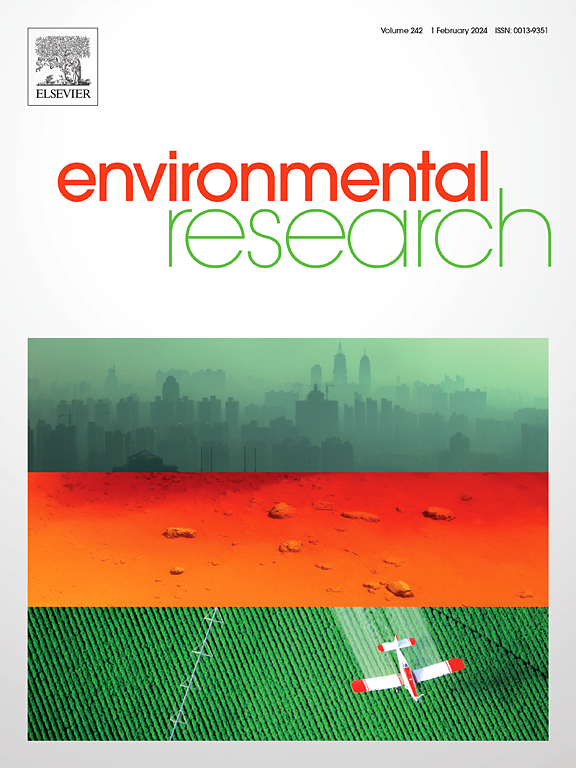Enhancement of aluminum doping on removal of norfloxacin by iron-loaded biochar: efficacy and mechanism
IF 7.7
2区 环境科学与生态学
Q1 ENVIRONMENTAL SCIENCES
引用次数: 0
Abstract
The capacity of aluminum/iron-loaded biochar (AFBC) and iron-loaded biochar (FBC) for removal of norfloxacin (NOR) was investigated by batch experiments, while enhancement efficacy and mechanism was explored by kinetic, isothermal, and thermodynamic analyses, as well as by characterization of the AFBCs and FBCs and solution properties. As the initial pH was raised from 2 to 12, the NOR removal capability of AFBC varied within a narrow range (123.6–124.4 mg g−1), which was 2.06–2.53 times that of FBC. The better description of the pseudo-second-order kinetic model, liquid film diffusion model, and Langmuir model indicated that NOR removal was dominated by surface monolayer chemisorption, and its rate-controlling step was mainly liquid film diffusion. Liquid film diffusion rates of AFBC and FBC were 7.01 × 10−2 and 1.75 × 10−2 min−1, whereas their maximum q-values were 205.8/72.77 (298 K), 222.9/84.42 (308 K), and 235.3/95.25 mg g−1 (318 K), respectively. NOR removal was spontaneous and endothermic, while more negative Gibbs energy change and lower enthalpy change of AFBC suggested that it was more beneficial for NOR removal. Adsorption and degradation of AFBC and FBC contributed 53.07 %/46.93 % and 61.76 %/38.24 % to NOR removal (298 K). The amounts of adsorption sites and free radicals (1O2, ·OH and ·SO4) derived from AFBC were 2.43 and 3.47 times those of FBC, respectively. AFBC and FBC had three similar pathways for degrading NOR, while AFBC significantly enhanced the contributions of ·OH and ·SO4. Furthermore, AFBC and FBC could be effectively desorbed and regenerated by ultrapure water and NaOH. In conclusion, the enhancement of NOR removal by aluminum doping on iron-loaded biochar was attributed to the elevation of affinity and the provision of more adsorption sites and free radicals.

铝掺杂增强载铁生物炭对诺氟沙星的去除效果及机理
通过批量实验考察了铝/铁负载生物炭(AFBC)和铁负载生物炭(FBC)对诺氟沙星(NOR)的去除能力,并通过动力学、等温和热力学分析,以及对AFBC和FBC的表征和溶液性质进行了探讨。当初始pH从2提高到12时,AFBC对NOR的去除能力变化范围很窄(123.6 ~ 124.4 mg g−1),是FBC的2.06 ~ 2.53倍。拟二级动力学模型、液膜扩散模型和Langmuir模型的较好描述表明,NOR的去除主要是表面单层化学吸附,其速率控制步骤主要是液膜扩散。AFBC和FBC液膜扩散速率分别为7.01 × 10−2和1.75 × 10−2 min−1,最大q值分别为205.8/72.77 (298 K)、222.9/84.42 (308 K)和235.3/95.25 mg g−1 (318 K)。NOR的去除是自发的、吸热的,而AFBC的负吉布斯能变越大,焓变越小,说明它更有利于NOR的去除。AFBC和FBC的吸附和降解对硝态氮(298 K)的去除率分别为53.07% / 46.93%和61.76% / 38.24%。AFBC得到的吸附位点和自由基(1O2、·OH和·SO4)分别是FBC的2.43倍和3.47倍。AFBC和FBC降解NOR的途径相似,但AFBC显著提高了·OH和·SO4的贡献。此外,AFBC和FBC可以被超纯水和NaOH有效解吸和再生。综上所述,在含铁生物炭上掺杂铝增强了对NOR的去除能力,这主要是由于铝提高了生物炭的亲和力,提供了更多的吸附位点和自由基。
本文章由计算机程序翻译,如有差异,请以英文原文为准。
求助全文
约1分钟内获得全文
求助全文
来源期刊

Environmental Research
环境科学-公共卫生、环境卫生与职业卫生
CiteScore
12.60
自引率
8.40%
发文量
2480
审稿时长
4.7 months
期刊介绍:
The Environmental Research journal presents a broad range of interdisciplinary research, focused on addressing worldwide environmental concerns and featuring innovative findings. Our publication strives to explore relevant anthropogenic issues across various environmental sectors, showcasing practical applications in real-life settings.
 求助内容:
求助内容: 应助结果提醒方式:
应助结果提醒方式:


